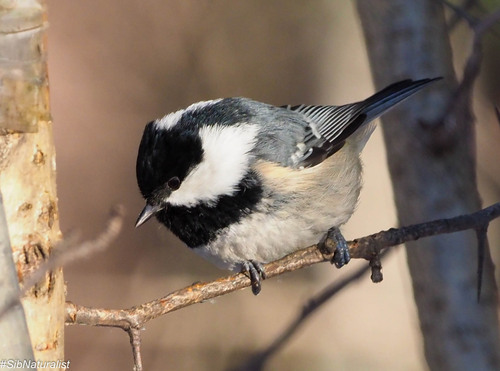
Coal Tit
The Coal Tit (*Periparus ater*) is a small, active passerine bird widespread across Europe, Asia, and parts of North Africa. It's a familiar sight in coniferous forests, where its agile foraging behavior and distinctive black cap make it easily recognizable. Unlike some of its more brightly colored relatives, the Coal Tit's subtle beauty lies in its contrasting plumage and energetic demeanor. Ecologically, it plays a significant role in controlling insect populations, particularly in forests. While not possessing major cultural significance, it is a welcome and cheerful presence in gardens and woodlands.
10-11.5 cm
Length
17-21 cm
Wingspan
Least Concern
Conservation Status
Distribution
The Coal Tit has a vast range, spanning across Europe, temperate Asia, and into North Africa. It extends from the British Isles and Iberia eastward through Russia to Japan, and south to the Atlas Mountains. It is largely resident, though some northern populations may undertake short-distance migrations.
Lifespan
Average lifespan in the wild is around 2 years, but some individuals can live longer.
Coal Tit's Habitat
Habitat Types
Coniferous forests, Mixed woodlands, Parks, Gardens
Climate Zones
Temperate, Boreal, Mediterranean
Adaptations
Coal Tits are well-adapted to coniferous forests. Their small size and agility allow them to maneuver through dense branches, and their fine beaks are ideal for extracting insects and seeds from cones and crevices. They are also adapted to storing food.
Variations
Numerous subspecies exist across the Coal Tit's range, differing subtly in plumage coloration and size. For example, British Coal Tits (*P. a. britannicus*) tend to be more olive-backed than continental European birds.
Appearance
Breeding Plumage
Plumage is generally similar year-round, though it may appear slightly brighter after molting.
Seasonal Feather Changes
Limited seasonal variation; fresher plumage after molt may appear slightly more vibrant.
Sex Based Plumage Differences
Males and females are very similar in appearance, although the black cap and bib may be slightly glossier in males.
Notable Features
Black cap and throat, White nape patch, White cheeks, Two white wing bars
Diet and Feeding
Primary Foods
Insects, Spiders, Seeds, Small invertebrates
Foraging Behavior
Coal Tits are active foragers, constantly searching for food among branches, leaves, and pine cones. They often hang upside down to reach insects and spiders. They are also known to hoard food, storing seeds and insects in crevices for later consumption.
Specializations
Their small, pointed beaks are well-suited for picking insects from crevices and extracting seeds from cones.
Seasonal Diet Variations
During the breeding season, the diet consists primarily of insects and spiders, providing protein for growing chicks. In winter, they rely more heavily on seeds, particularly those of conifers.
Behavior
Social Structure
Coal Tits are generally territorial during the breeding season, defending their nesting area. Outside of the breeding season, they may form small flocks, sometimes joining mixed-species foraging flocks with other tits and small birds.
Communication
Variety of high-pitched calls, A distinctive 'pitchu' call, Song consisting of rapid, repeated notes
Migration
Most populations are resident, but some northern populations may undertake short-distance movements in response to harsh weather or food shortages.
Territorial or Group Behaviors
Territorial during breeding; forms small flocks, often with other tit species, in winter.
Conservation
Threats
Habitat loss (particularly loss of mature coniferous forests), Pesticide use (affecting insect prey), Climate change (potentially altering breeding timing and food availability)
Protection Programs
General habitat protection measures, Promotion of sustainable forestry practices
Local National Laws
Protected under various national and international wildlife legislation, such as the EU Birds Directive.
Population Trend
Stable
Population Estimates
The global population is estimated to be very large, with tens of millions of pairs in Europe alone.
Interesting Facts
Coal Tits are known for their food-hoarding behavior.
They store seeds and insects in crevices, under bark, or in the ground, remembering the locations for later retrieval.
They can often be seen hanging upside down while foraging.
This acrobatic behavior allows them to access food sources that other birds might miss.
The white nape patch is thought to play a role in communication.
It may be used in displays or to signal alarm.
Faqs about Coal Tit
What do Coal Tits eat?
They eat a variety of insects, spiders, and seeds, with their diet shifting seasonally.
Where do Coal Tits nest?
They nest in tree cavities, holes in walls, and sometimes nest boxes.
Are Coal Tits migratory?
Most populations are resident, but some northern populations may move short distances in winter.
How can I attract Coal Tits to my garden?
Provide a source of food (such as sunflower seeds or peanuts), water, and nesting opportunities (such as nest boxes or dense vegetation).
Copyright @ Nature Style Limited. All Rights Reserved.
 English
English